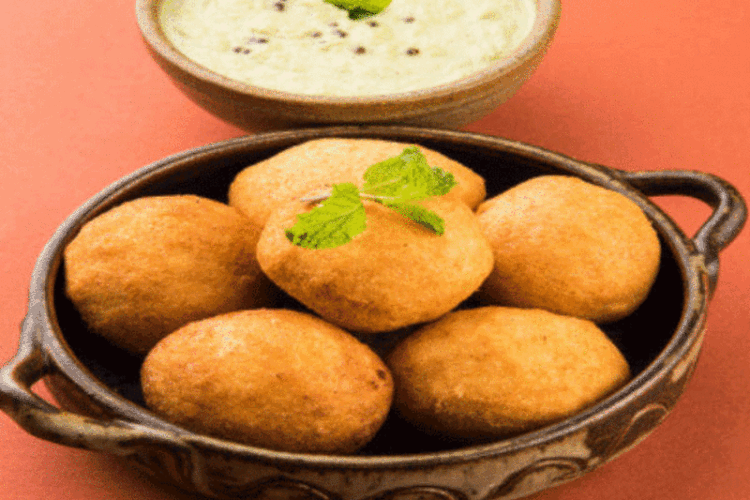Punugulu recipe, also known as Punukulu or Paniyaram, is a popular South Indian snack that is typically made with leftover dosa or idli batter. It is a crispy and fluffy snack that is usually served with chutney or sambar.
The batter used to make the Punugulu recipe is typically prepared by soaking a combination of rice and lentils (such as urad dal) for a few hours and then grinding them into a smooth paste. This batter is fermented overnight, which gives it a light and airy texture. However, the Punugulu recipe can also be made quickly using leftover dosa or idli batter, making it a convenient snack option.
The batter is seasoned with ingredients like chopped onions, green chilies, cilantro (coriander leaves), and sometimes ginger. These ingredients add flavor and texture to the fritters. The batter is then deep-fried in hot oil until they turn golden brown and crispy on the outside.
Punugulu recipe is often served with chutneys like coconut chutney, tomato chutney, or mint chutney, and sometimes with sambar (a lentil-based vegetable stew). They are commonly enjoyed as a snack, appetizer, or even for breakfast.
Ingredients of Punugulu recipe:
- 2 cups dosa or idli batter
- 1 onion, finely chopped
- 1 green chili, finely chopped
- 1/4 cup chopped cilantro (coriander leaves)
- 1/2 teaspoon ginger, grated (optional)
- Salt to taste
- Oil for deep frying
Instructions for punugulu recipe:
- In a large mixing bowl, take the dosa or idli batter. If the batter is too thick, you can add a little water to adjust the consistency. It should be pourable but not too runny.
- Add the finely chopped onion, green chili, cilantro, grated ginger (if using), and salt to the batter. Mix well until all the ingredients are evenly combined.
- Heat oil in a deep frying pan or kadai over medium heat.
- Once the oil is hot, take small portions of the batter with a spoon or your hand and drop them gently into the hot oil. You can make them in small round shapes or slightly flattened shapes.
- Fry the punugulu until they turn golden brown and crispy on all sides. Make sure to flip them occasionally to ensure even cooking.
- Once they are cooked, remove them from the oil using a slotted spoon and place them on a plate lined with paper towels to absorb excess oil.
- Repeat the process with the remaining batter, frying them in batches, until all the batter is used.
- Serve the Punugulu hot with coconut chutney, tomato chutney, or sambar.
Tips
- The batter should be thick and pourable, similar to the consistency of pancake batter. If the batter is too thin, the Punugulu may become flat and absorb more oil during frying. If the batter is too thick, the fritters may not cook evenly. Adjust the consistency by adding a little water or batter as needed.
- If you are making the batter from scratch, allow it to ferment overnight or for at least 6-8 hours. Fermentation helps in making the Punugulu light and fluffy. If using leftover dosa or idli batter, ensure that it is well fermented.
- Add finely chopped onions, green chilies, cilantro, and grated ginger to the batter for extra flavor. You can adjust the amount of these ingredients based on your preference.
- Maintain the oil at medium heat throughout the frying process. If the oil is too hot, the Punugulu may cook too quickly on the outside while remaining uncooked inside. If the oil is not hot enough, the fritters may absorb more oil and become greasy.
- Make the Punugulu in small, bite-sized portions for even cooking. You can shape them into small round balls or slightly flattened discs. Avoid making them too large, as they may not cook evenly.
- After frying, place the Punugulu on a plate lined with paper towels to remove excess oil. This helps in making them less greasy.
Variation
- Rava Punugulu: Instead of using rice and lentils, this variation uses semolina or rava as the main ingredient. The batter is prepared by mixing rava with yogurt or buttermilk, along with chopped onions, green chilies, and spices. The rest of the process remains the same, and the result is crispy and flavorful rava Punugulu.
- Vegetable Punugulu: This variation includes adding a variety of finely chopped vegetables to the Punugulu batter. You can use vegetables like carrots, bell peppers, corn, grated zucchini, or finely chopped spinach. The addition of vegetables adds color, texture, and nutrition to the fritters.
- Masala Punugulu: In this variation, the batter is spiced with a mix of spices like cumin seeds, fennel seeds, black pepper, and curry leaves. These spices enhance the flavor of the Punugulu and give them a unique taste. You can also add a pinch of asafoetida (hing) for additional flavor.
- Pesarattu Punugulu: Pesarattu is a popular South Indian crepe made with whole green gram (moong dal). You can make mini Pesarattu by cooking the batter in small circles or discs. These mini Pesarattu are then deep-fried to make Pesarattu Punugulu. They have a slightly different texture and taste compared to the regular Punugulu.
FAQs
Q: Can I make a Punugulu recipe without deep frying?
A: Punugulu recipe is traditionally deep-fried for a crispy texture. However, if you prefer a healthier alternative, you can try baking them in a preheated oven at around 200°C (400°F) until they turn golden brown. Brush the Punugulu with a little oil before baking to help achieve a crispy exterior.
Q: Can I make a Punugulu recipe with gluten-free ingredients?
A: Yes, Punugulu recipes can be made with gluten-free ingredients. Instead of using regular wheat-based flour, you can use gluten-free flour like rice flour, chickpea flour (besan), or a combination of different gluten-free flour. Adjust the batter consistency accordingly for the best results.
Q: Can I freeze the Punugulu recipe?
A: Punugulu recipe is best enjoyed fresh and crispy. However, if you have leftovers, you can freeze them in an airtight container for up to a month. When you want to eat them, reheat them in a preheated oven or toaster oven until they are heated through and crisp again.
Q: Can the Punugulu recipe be served as a main course?
A: Punugulu recipe is typically served as a snack or appetizer. They can also be part of a meal, especially if served with a side of sambar or chutney. However, Punugulu is not usually considered a main course dish on its own.
Nutrition
| Calories | 500 kca |
| Fat | 15 g |
| Carbohydrates | 60 g |
| Sodium | 284 mg |
| Potassium | 505mg |
| Protein | 10 g |
| Vitamin A | 959 IU |
| Calcium | 343 mg |
| Vitamin C | 1 mg |
| Iron | 1mg |
Also, read:
- Chicken Momos Recipe (step by step)
- Paneer do pyaza recipe
- how to make paneer butter masala
- Palak Paneer Recipe
- Paneer Dum Biryani Recipe
follow us on Instagram, Facebook and youtub




